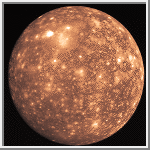

Actually, considering the age of that meteorite, the question should be: Has there ever been life on Mars?
Unfortunately, the NASA site concerned with life on Mars is either gone, down,
or never running when I try to access it these days, so I've nuked my link to it.
At the moment, however, you can go visit the Mars Pathfinder Mission site, wherein you can see Sojourner sojourn around the Red Planet, as well as broad vistas of lifeless red stuff (which the Martians have cleaned up out of consideration for us; little do we know...)
You Decide. Can you spot the otters basking down there somewhere?


|
IO
(NASA, Galileo) |

Looming on a far horizon is our world's brushup with a dust cloud. I've some
tongue-in-cheek observations to make about this.
Go to the top of the page.
Visit Diann's
home page. Or dig things up in her Library.
Or visit scenic Scotland. Or
listen to Diann's odd taste in Music. Or root
around in her Garden, and pull up some weeds
for her while you're there. Last Updated: July 22, 1997.
DUST CLOUD ALERT

COMET ALERT
![]() Comet Page,
Sky and Telesope
Comet Page,
Sky and Telesope
![]() Comet Hyakutake,
European Southern Observatory
Comet Hyakutake,
European Southern Observatory
![]() Comet Hale-Bopp, Jet
Propulsion Laboratory.
Comet Hale-Bopp, Jet
Propulsion Laboratory.

I mean, this is what the Internet is allegedly known for -- Weird Stuff!!! Not
that I didn't ever run into lots of Weird Stuff before using the 'Net!
![]() Chuck Shramek's comet site.
This is the fellow that evidently got the ball rolling on the speculations and such.
He's an amateur astronomer. Interesting to poke around here.
Chuck Shramek's comet site.
This is the fellow that evidently got the ball rolling on the speculations and such.
He's an amateur astronomer. Interesting to poke around here.
![]() What Is the
Truth about Comet Hale Bopp?, a site whose author questions what he believes NASA isn't
saying, about cometary orbital changes, a discussion on catastrophe, and the relevance of Shoemaker-Levy 9
(the comet which hit Jupiter a couple summers ago). Written well enough to stir some doubts. Perhaps.
What Is the
Truth about Comet Hale Bopp?, a site whose author questions what he believes NASA isn't
saying, about cometary orbital changes, a discussion on catastrophe, and the relevance of Shoemaker-Levy 9
(the comet which hit Jupiter a couple summers ago). Written well enough to stir some doubts. Perhaps.
![]() Enigma. Some
enigmas relating to a "Saturn-Like Object" (SLO) photographed near the incoming comet,
which allegedly moves with the comet. This site reminds me of the Weekly World News,
although better written.
Enigma. Some
enigmas relating to a "Saturn-Like Object" (SLO) photographed near the incoming comet,
which allegedly moves with the comet. This site reminds me of the Weekly World News,
although better written.
![]() Comet Hale-Bopp gets yet
another Home Page. Some fine art by SF artist Joe Bergeron, and an explanation for the
SLO more generally accepted by the astronomical community. As well as e-mail both pro and
con. Frankly, I think any such object is an artifact of photography, and any excess
hype is an artifact of the Internet. But such things, as
long as one doesn't take them too seriously, serve to amuse. Anyhow, this site does have
lots of other Hale-Bopp information at hand as well.
Comet Hale-Bopp gets yet
another Home Page. Some fine art by SF artist Joe Bergeron, and an explanation for the
SLO more generally accepted by the astronomical community. As well as e-mail both pro and
con. Frankly, I think any such object is an artifact of photography, and any excess
hype is an artifact of the Internet. But such things, as
long as one doesn't take them too seriously, serve to amuse. Anyhow, this site does have
lots of other Hale-Bopp information at hand as well.

CALLISTO

Go, Galileo, Go!!!
(Photo by NASA, Calvin J. Hamilton)